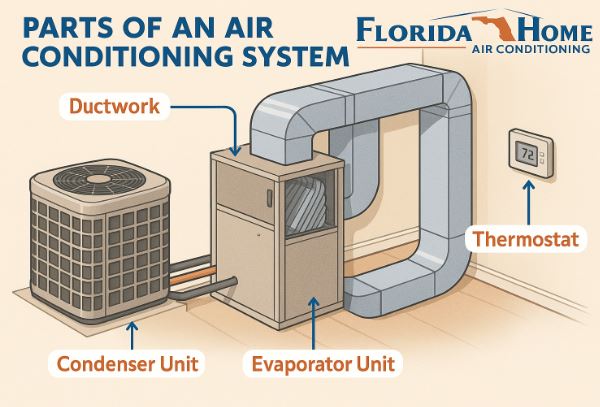All the Parts of an Air Conditioning System

Understanding the Essential Parts of Your Central Air Conditioning System
Central air conditioning distributes cooled air to every room in your home via a central cooling system. This article will help you understand the most important parts of an AC unit. Knowing the basics about the parts of an air conditioning system will allow you to understand how it keeps your home cool and why certain parts need repairs from time to time.
Since the 1970s, central air conditioning systems have been popular in homes across America, offering comfort and convenience in every room via a single thermostat control. Central air conditioning systems have several key components that produce cool, dry air for home comfort on hot days. Understanding how each of these parts works together and how to spot trouble can help you maintain your central air conditioning system for better performance year after year.
Here are the central air conditioner parts that you should get to know:
Condenser Unit
Central air conditioning systems utilize two main components: an outdoor condenser and an indoor evaporator. The outdoor condenser is housed inside a metal cabinet with slats, called fins, along the sides to direct airflow. Condensers are typically located on a concrete pad beside your home but may also be located on your roof. When heat is removed from your indoor air by the evaporator, it is absorbed by a refrigerant that is sent to your condenser, where the heat is radiated away to the outdoor air. Once the refrigerant has released its heat, it is pumped back into your home to begin the cooling process again.
The best way to keep your condenser working properly is to clear the area around it of debris and keep landscaping trimmed back for at least three feet in all directions. You can clean your condenser using your hose or have your HVAC technician perform this task during regular maintenance visits.
Evaporator Unit
Inside your home, the air conditioner's evaporator unit draws air across the evaporator coil. This coil contains the refrigerant, which absorbs heat from the air to cool it. Once the air has been cooled, it is blown through your ducts by an air handler. If you have a central furnace installed as well, your air conditioner and furnace will share the same electric air handler system.
Your HVAC technician should clean your evaporator during maintenance visits; additionally, changing the air filter in your air A/C's intake regularly will help to keep the system free of dust and dirt, as well as reduce strain on the blower motor by improving airflow.
Ductwork
Central air conditioning systems use ductwork to carry cooled air throughout your home. Cooled air is blown into a central duct by your air handler, which branches out into each conditioned space in your home. Ducts end in air registers, which contain adjustable grilles that can be opened or closed to allow for more or less airflow.
You can clean your air registers using the hose attachment of your vacuum; make sure not to block registers with furniture or other items. Avoid closing too many registers at once, as this can increase the strain on your air handler.
Thermostat
The thermostat is the control center for your home's central cooling system. Based on your temperature setting, your thermostat prompts your air conditioner to run by comparing your set temperature with the ambient temperature in your home. Thermostats should be placed in a shaded area, out of range of any air registers that may affect its temperature reading. If your air conditioning system seems to run too often or not often enough, it could be an issue with your thermostat.
New advancements in smart thermostats add a higher level of control than were previously available with older models. These devices can now be controlled by a smartphone and can even allow you to set specific temperatures for certain times of day, different rooms, and a variety of other settings. If you do not have a good thermostat, consider having an updated thermostat professionally installed in your home.
Caring For Your Unit
Now that you understand the main parts of your central AC system, you have the foundation to ensure you are taking care of your home's central air conditioning system. Part of ensuring that your system runs smoothly means following smart cooling practices and scheduling regular professional tune-ups to maximize efficiency. An HVAC professional can help you manage simple maintenance and repairs and keep your system running as smoothly as possible during its lifetime.
